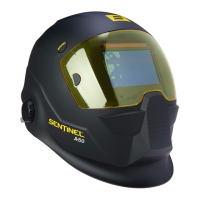
Do you have a question about the ESAB Sentinel A50 and is the answer not in the manual?
| Viewing Area | 100 x 60 mm (3.93 x 2.36 in.) |
|---|---|
| Optical Class | 1/1/1/2 |
| Sensors | 4 |
| Shade Range | 5-13 |
| Power Supply | Solar cell |
| Battery Type | CR2450 |
| Switching Time | 0.0001 seconds |
| Standards | ANSI Z87.1, EN 379 |
General safety advice, warnings, and precautions for operating the auto-darkening welding helmet.
Headgear unevenness causing distance issues between eyes and filter lens.
Check cover lens, sensors, current, battery for darkening issues.
Filter response time affected by low operating temperatures.
Causes include soiled lenses, insufficient light, incorrect shade, or protective film.
Headgear requires readjustment for a secure and stable fit.
Properly install the battery by sliding out the cover, inserting the battery, and closing.
Turn on the ADF by striking an arc or pressing the 'DISPLAY' button.
Shows the current state of the solar cell and battery power levels.
A yellow border highlights the currently selected option on the digital screen.
Switch to grind mode via display or long press on external control.
Adjust shade number for welding/cutting by touching 'SHADE' and adjustment buttons.
Adjust lens sensitivity to arc light using 'SENSI.' button; 5-10 is normal.
Set the time for the lens to return to clear state after welding using 'DELAY' button.
Save and recall up to 8 sets of pre-defined welding parameters for convenience.
Adjust headband size using the rear knob for a secure fit.
Adjust the top strap to position the helmet correctly on your head.
Use 'LOCK' latch to adjust helmet-to-face distance for even darkness.
Adjust tilt using the lever on the right headgear tension knob.
Information on testing body (DIN CERTCO) and applicable certifications (CE, EN175).
Details the meaning of the markings and classification numbers on the ADF.
Instructions for replacing front and inside cover lenses without damage.
How to safely remove and install the ADF unit using side latches.
Clean helmet, sensors, and solar cells with soft cloth and methylated spirit.
Optical class, viewing area, arc sensor, light/grind states, modes, and protection.
Details power supply, switching time, TIG rating, operating/storing temperatures.
Specifies helmet material, application range, and product approvals/standards.
Recommendations for shade numbers based on welding/cutting operation and current.
Comprehensive list of all helmet parts with their corresponding part numbers.
Diagrams and brief notes on how to assemble the helmet components.